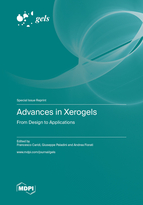Advances in Xerogels: From Design to Applications
A special issue of Gels (ISSN 2310-2861). This special issue belongs to the section "Gel Processing and Engineering".
Deadline for manuscript submissions: closed (28 February 2023) | Viewed by 25850
Special Issue Editors
Interests: environmental radioactivity; gamma spectrometry; liquid scintillation; alpha spectrometry; gas radon detection; emanometry; ionizing radiations
Special Issues, Collections and Topics in MDPI journals
Interests: biopolymers; xerogels; nanocellulose; drug delivery systems; FTIR-ATR spectroscopy; Raman spectroscopy; neutron spectroscopy; material characterization
Special Issues, Collections and Topics in MDPI journals
Interests: nanocellulose; biomaterials; materials characterization; chemical-physical approaches; nanostructured and composite materials; hydrogels; mass transfer phenomena; food packaging
Special Issues, Collections and Topics in MDPI journals
Special Issue Information
Dear Colleagues,
The design of novel xerogels for several applications has become a hot topic in the field of material science and engineering. Since their structures and morphologies can be conveniently controlled during the synthesis process, the development of xerogels has gained increased interest within the scientific community.
Based on these considerations, this Special Issue of Gels aims at collecting high-quality papers on the latest breakthroughs and advances in the field of the xerogels science from design to application. In particular, we encourage submissions focused on both well-established and/or non-conventional methods for the synthesis and characterization of xerogels. The aim is to obtain insights into fundamental and applied aspects related to any kind of organic/inorganic xerogel-like materials. Cutting-edge studies, both theoretical and experimental, focused on the structural, chemical, rheological and dynamical properties of xerogels and xerogel-based derivatives are warmly welcomed.
As Guest Editors, we would like to kindly invite you to contribute a research paper or a review on any topic related to this thread.
Prof. Dr. Francesco Caridi
Dr. Giuseppe Paladini
Dr. Andrea Fiorati
Guest Editors
Manuscript Submission Information
Manuscripts should be submitted online at www.mdpi.com by registering and logging in to this website. Once you are registered, click here to go to the submission form. Manuscripts can be submitted until the deadline. All submissions that pass pre-check are peer-reviewed. Accepted papers will be published continuously in the journal (as soon as accepted) and will be listed together on the special issue website. Research articles, review articles as well as short communications are invited. For planned papers, a title and short abstract (about 100 words) can be sent to the Editorial Office for announcement on this website.
Submitted manuscripts should not have been published previously, nor be under consideration for publication elsewhere (except conference proceedings papers). All manuscripts are thoroughly refereed through a single-blind peer-review process. A guide for authors and other relevant information for submission of manuscripts is available on the Instructions for Authors page. Gels is an international peer-reviewed open access monthly journal published by MDPI.
Please visit the Instructions for Authors page before submitting a manuscript. The Article Processing Charge (APC) for publication in this open access journal is 2600 CHF (Swiss Francs). Submitted papers should be well formatted and use good English. Authors may use MDPI's English editing service prior to publication or during author revisions.
Keywords
- Xerogels synthesis
- Xerogels fundamentals
- Xerogels properties
- Xerogels applications
- Physical-chemical features of xerogels
- Xerogels structural-property correlations
- Xerogels dynamical-property correlations.









